By Marco Santana

It was rudimentary, he admits.
After all, it was the late 1980s.
Still, the technology fascinated him and he was hooked.
Hough changed his major to interactive multimedia systems design, a relatively new major at the time, and it set him off toward a life of early tech adoption and curiosity.
“Nobody understood it then,” he said. “My family said that I majored in video games, but I wanted to use the technology to teach.”
Now, that curiosity and commitment to discovering and implementing technology has led him to Beacon College. Hough, 56, started as the school’s chief information officer in June.
Hough comes to Beacon after having built the technology infrastructure for Covenant Theological Seminary and Logan University in Missouri.
He also helped usher in a period during which both institutions increased the use of tech for instruction.
That has become an initiative at Beacon College.
“When I heard about Beacon and its mission looking to solidify technology on the institutional level, I love that vision,” said Hough, who earned bachelor’s and master’s degrees from Western Washington University before pursuing a Ph.D. in education and human development for instructional technology at Vanderbilt. “I am excited to be a part of helping with the tech side of things.”
Hough brings some extensive experience into this executive position. He served in the president’s cabinet at Logan University. He was responsible for budget management, hiring and supervising personnel. In addition, he was involved in the school’s short- and long-term planning and enterprise-wide tech projects.
At Covenant, he helped roll out a conversion of the campus’ software system. “Behind it all is educating the student and the person,” Hough said.
His career has run parallel with some of the more impressive developments of technology in the classroom. And his career intersected with the creation, launch, development and growth of the Internet.
In fact, in his early career, he was tasked with streamlining a graphics-heavy website that took far too long to load. Through an assistive technology framework, he reduced the load time to seven seconds.
More recently, he has been tracking some of the more modern tech-related challenges facing educators.
The emergence of artificial intelligence-based content has schools across the country seeking ways to ferret out students who might use it on assignments. Hough stresses it is just the latest adjustment educators need to make.
“It’s like plagiarism,” he said. “It’s been around as long as people have been writing but educators have long been teaching about the importance of not plagiarizing.”
Using artificial intelligence isn’t inherently bad, Hough said.
Sometimes, students can use it to feel more comfortable with writing or putting together a project. However, it’s imperative that administrators and educators teach students about the perils of over-reliance.
“There is an argument that they know the material but are not good at organizing,” he said. “When you combine the understanding that there is a place for it but also educate students on how to properly use it, it becomes a discussion about making sure they do it right. For students who do struggle with organizing or writing an essay, having an AI to help them do that better, there is a place for it.”
As Hough settles into his role, his priorities will expand to incorporate not just helping students and making sure the school’s tech infrastructure is solid. He also has his sights set on putting tools in place that will help the business office become more efficient.
Additionally, students’ interaction with the business office and other departments will be simplified using technology. Hough said this is partly because the state of edtech today has increasingly included more widespread access to portals that contain student records and other information they may need.
“It’s all part of the same tapestry of technology at an institution,” he said. “This helps students feel a little bit more control and helps prepare them to go into the workforce.”
Hough said he has been impressed at how early Beacon College targets career readiness. While he has seen other schools wait several semesters to do that, Beacon has that as a part of its plan for students from day one, he said.
That means years of constantly keeping students focused on their careers with mentorship and guidance along the way.
“This is one of the best-kept secrets in America,” he said. “The staffing ratio is unreal. We are working on making everything reliable, resilient and robust.”